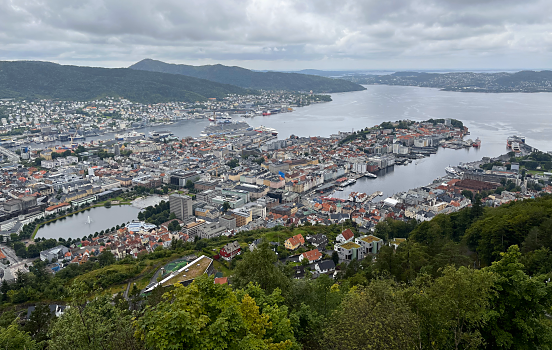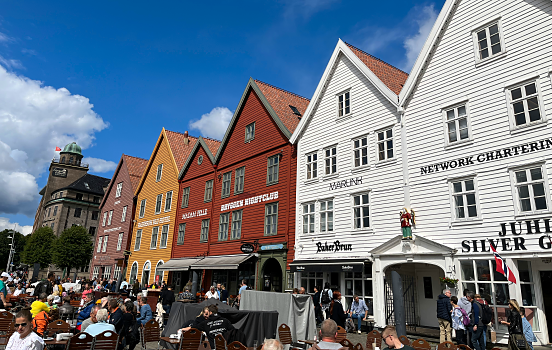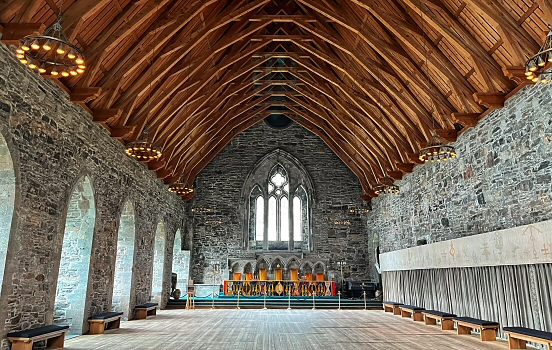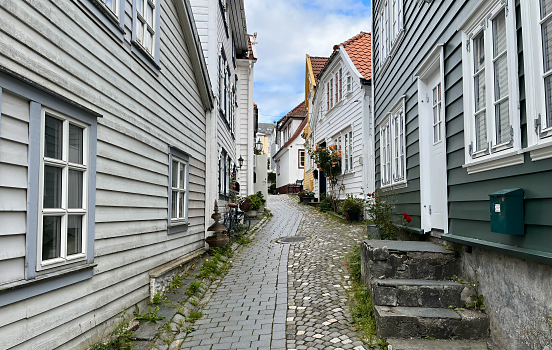As I look down on the city of Bergen from nearby mountain Fløyen, I try to understand the unique atmosphere of this place. Bergen is jammed tightly between fjords and seven mountaintops, nicknaming it “city of seven mountains”.
The view is spectacular and it almost feels like the enchanting melodies of Edvard Grieg still hangs in the air, 180 years after he was born in Bergen. The composer lived in a large villa called Troldhaugen, which is situated south of the city and open to the public as a museum. He also died in the city and his statue can be seen looking up at the imposing concert hall Grieghallen.
The forest area surrounding Bergen is quite spectacular. I pass small waterfalls, strange statues and the largest tree of Norway (or so the sign says). I am completely alone out here, not even a mosquito. The only thing I hear are birds and the waterfalls.
 View from Fløyen.
View from Fløyen.
At first glance, Bergen seems to be staying a lot in the past. The former home of Grieg is one of the most popular places to visit. Several works of Edward Munch is on display inside the Kode museum, which is worth a look. The reconstructed Bryggen area is like a museum of the Hansa age, said to be the most visited tourist attraction in all of Norway (which becomes painfully obvious for anyone foolish enough trying to pass through the narrow streets in the area).
 Bryggen. Not for the faint of heart.
Bryggen. Not for the faint of heart.
North of Bryggen is the open-air museum Old Bergen with historic wooden buildings. The city is full of tiny streets such as Knosesmauet, which feels like they would have looked the same a hundred years ago. Even nature itself is reminding me of the past, as I walk past a sign in front of a tree, naming it the “largest tree in Norway”, planted in year 1900.
 Håkonshallen – hall of the mountain king.
Håkonshallen – hall of the mountain king.
Another reminder of the past is the Bergenhus Festning. This was the the royal palace when Bergen was still the capital of Norway, until about 1300 AD. I walk past the tall tower of Rosenkrantztårnet into Håkonshallen, a very impressive hall fit for a king. Unfortunately the old buildings were razed in an explosion 1944, but have since been rebuilt.
The old fortress areas of Sverresborg and Fredriksberg turned out to be mostly overgrown with only remnants left of the once great walls.
 Lots of narrow streets in the city.
Lots of narrow streets in the city.
Even some of the nightlife appears to be leaning on the past. There is a small room inside Grand Hotel Terminus which houses the Bar Amundsen. The famous polar explorer Roald Amundsen held his last press conference in the bar 1928, where also the last known photograph of him was taken before his journey to Svalbard where he went missing the next day. I sit down at the counter with a fine single malt and soak up the ambience in the empty room, trying to imagine the grizzled old men sitting in here almost hundred years ago.
But all is not lost in the past. I want to envision a Bergen in the present, it is after all the second-largest city in Norway. So I walk all across the city in the search for modern gems. I see trendy espresso cafés proudly roasting their own beans, fashionable wine bars boasting only the best Italian wines, a large aquarium with otters, eclectic cocktail bars that only use QR codes (which made an older patron go berserk), artisan pastry stores and a hip vinyl record store doubling as a craft beer mecca. To top it all off, I find a black metal pub with a shrine to the murdered Euronymous of Mayhem and shady altar of worship to Dimmu Borgir.
Bergen, living in both present and future.

Comments
No comments yet.
Leave a reply